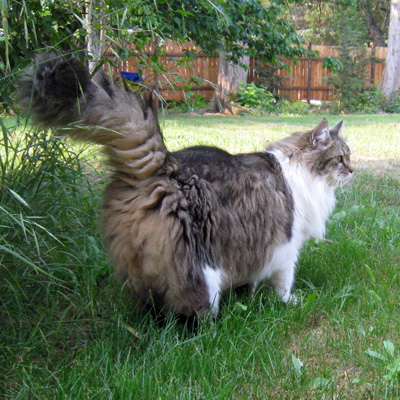Current Article ∙ Archive ∙ Back to Island Voices
The Bursting Bladder
by Jeff Grognet, DVM, BSc (Agr) and Louise Janes, BSc(Agr), DVM
How would you feel if you couldn’t pee? No matter how hard you strain, you just can’t empty your bladder.
As the kidneys produce more urine, the bladder gets excruciatingly fuller. It must be ready to burst.
Just like a balloon being filled, continued urine production raises the bladder pressure. As it reaches a peak, the pressure backs up to the kidneys. Urine flow is halted. Without urine production, poisons build up in the blood. Nausea sets in and vomiting starts.
Blood toxins rise to lethal levels. Body-wrenching convulsions are triggered in the brain. Lactic acid, a byproduct of excess muscle activity, combines with other toxins in the blood stream. Coma sets in.
Relief ultimately comes through death.
You would think that we’ve described some formidable torture that a scant few would wish even on their worst enemy. This is actually a description of the most common disease seen in male cats. Commonly referred to as feline urological syndrome (FUS) or feline lower urinary tract disease (FLUTD), it is a fatal blockage of urine flow due to bladder crystals.
Veterinarians see this disease with unfaltering regularity. It is a direct result of the foods that we feed to our cats. Minerals from the food form crystals in the bladder. These subsequently impede urine flow.
Don’t get the wrong idea, minerals are indispensable. They form an fundamental part of the diet. Minerals function as cofactors in enzymes, are integral structural elements in bone, form a crucial part of hemoglobin, and supply countless other needs.
Minerals ingested as part of food dissolve in intestinal juices during normal food digestion. Once dissolved, they pass through the intestinal wall into the blood stream. Minerals are then distributed throughout the body to any part that demands them.
Excess minerals are eliminated in the urine. This is how difficulties begin. Cats have the capacity to concentrate their urine exceedingly well. It also means that the mineral concentration can be extremely high. Minerals can get so concentrated that they can precipitate (come out of solution) and form small crystals.
Precipitation can be understood by thinking of a science experiment that you probably did in grade school. Do you remember dissolving some salt in a little water and then leaving it in a glass?
As the water eventually evaporated, small salt crystals formed around the rim of the glass. Bladder crystals form the same way. Few ever grow any bigger than a sand grain. But, this small size is sufficient to kill a cat.
Female cats do not get life-threatening obstructions with bladder crystals. Their anatomy provides a large exit from the bladder. Crystals pass out easily.
Irritation of the bladder mucosa (the delicate inside lining of the bladder wall), can be indicated by blood appearing in the urine. Recurring cystitis (bladder infection) is another possibility.
Male cats, on the other hand, are built differently. The urethra, or exit from the bladder, courses through a narrow penis. The diameter is extremely small.
Crystals often do pass through the urethra with no problem at all. Irritation due to the crystal passing creates an urgency to urinate. Some cats temporarily spray. Crystals in the bladder of a male cat can also initiate a bladder infection.
Other times, crystals may only make it part way, especially if they are large. These will bruise, scratch, or lacerate the lining of the urethra. Like any tissue in the body, damage creates tissue swelling. If the crystal is lodged in the urethra, the swollen lining closes down on it. An impenetrable blockage results.
Though the cat desperately tries to get urine to pass, it fails. The dramatic sequence outlined above then comes into play. Only one solution will work now. Emergency care by a veterinarian is essential to save the cat’s life.
A blocked cat is elementary for a veterinarian to diagnose. In fact, just a description of the cat’s behaviour will often be a clue. One symptom is that they try to urinate in strange places—the bathtub being one of them.
We don’t know why they choose spots like this. There is conjecture that the cool surface is soothing to sore tissue. Another idea is that the cold surface stimulates a cat to urinate. We don’t appreciate cat psychology well enough to really know the answer.
A definite diagnosis is made when the bladder is felt. It is just like a hard ball. When squeezed, it results in extreme pain. This is one of the few times you’ll get a cat to cry. Even broken bones don’t seem that painful to a cat.
Once FUS is confirmed, the next step is to alleviate the blockage. General anesthetics are usually needed to restrain the cat and enable the veterinarian to complete the painful backflushing of crystals. A minute catheter is inserted into the penis and saline solution is used to propel the crystals back into the bladder. The catheter is then used to withdraw all the urine.
The period of time the catheter is left in place depends on how much damage there is to the urethral lining. No clear guidelines exist. Though catheters may be left in for 3 or 4 days, some cats will reblock once the catheter is removed. The process then has to be repeated.
In cats that repeatedly block, surgery can be performed. This is used when the urethra has been severely damaged.
It is best to prevent FUS in the first place. This is accomplished by feeding the right food. The question then becomes, what is the right food? We’ll go through the way that foods have evolved to treat FUS.
We have all seen foods that are sold under the “low ash” label. Restricting ash content was the first step in diet formulation to prevent this disease. Ash is the residue left after the food has been burnt in an oven. The ingredients with the highest ash content are the cheaper ingredients (e.g. bone meal). Because of this, some foods have incredibly high levels.
Minerals are the main component of ash. The reasoning behind this diet formulation is to restrict the intake of minerals that form crystals.
Cats with a history of FUS can re-block on “low ash” foods. Ash content alone is not the full answer. We need to look further.
The next step tried in formulating diets to prevent FUS was to lower the amount of magnesium. This mineral is a basic part of the struvite crystals that form in the bladder.
Again, some cats still block on these diets.
Specially-made prescription diets are the next step. These are formulated to be fed to cats that have blocked in the past. Three rationales come into play for them to be effective. They lower the amount of magnesium, ensure that urine produced has an acidic pH, and increase the caloric density so that the intake of food (and minerals) is kept to a minimum.
The incidence of bladder crystals has gone down remarkably. But, we still see it. Is diet the only reason we see this disease? Are other factors involved?
Yes, and it is the simplest of them all. It is the water content of the diet. And, we can use it to avoid this disease. Cats eating “natural” diets (mice and birds) don’t seem to have any problems. Could it be that we are just feeding the wrong thing? Manufacturers commonly add plant protein to cat food because it is cheaper. Cats are carnivores. They do not go out of their way to eat plants.
The answer is to feed a wet food exclusively. This can be a canned food, but it has to contain mainly meat ingredients (no grains). The ones we recommend are Wellness, Evo, and Instinct. Our cats eat canned food only, and no, it doesn’t mean they have tooth problems. You can also consider feeding real meat. Take a look at the web site below for information.
For more information contact Dr. Jeff Grognet or Dr. Louise Janes at
Mid-Isle Veterinary Hospital
5-161 Fern Road West
Qualicum Beach, BC
Tel (250) 752-8969


